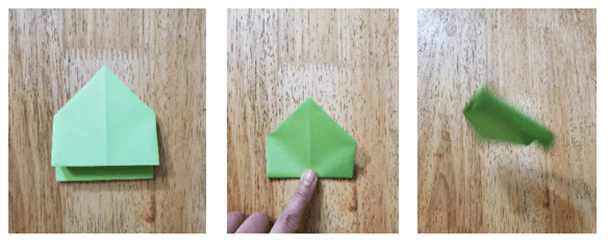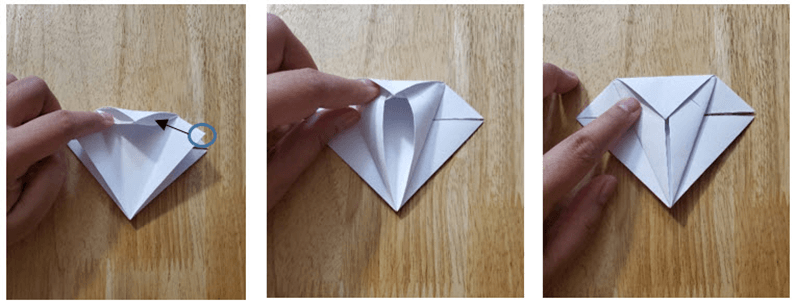Description
Participants will create origami jumping frogs, then they will make the frogs jump and record the results.
There are instructions to make beginner and intermediate frogs.
Options for comparing frogs:
- Make a beginner frog in one size and then make another with smaller paper
- Make an intermediate frog in one size and then make another with smaller paper
- Make a beginner frog and an intermediate frog with the same size paper
Bonus: Participants can have a frog-jumping competition to see which frog can jump the farthest or have a frog-jumping race.
Number of participants
For any number of participants
Space considerations
An indoor space where participants can be seated to do a craft
Competencies
- Eye-hand coordination
- Following directions
- Logic and sequencing
- Spatial relationships
Materials
- Perfect rectangle paper (must be able to make two perfect squares from it)
- To make smaller rectangles, cut the rectangle in half to make two squares, then cut the squares in half
- Scrap paper to record results
- Crayons, markers or pencil crayons
- Pencils and erasers
- Rulers or measuring tape
- Liquid glue or glue sticks (optional)
- Projector and screen (optional)
- Microphone (optional)
- Tactile elements (optional)
- Foam shapes
- Foam stickers
- Googly eyes
- String, twine, yarn or ribbons
- Stickers
Preparation
- Print origami frog instructions with images for participants to take away
- We recommend making this available after you instruct, as some participants will finish quicker or get confused if the instructions are handed out ahead of time
- Set up screen and projector (optional)
- Set up a microphone (optional)
Implementation
Crease: A line created on the paper after folding it. Creases help fold more neatly and accurately.
BEGINNER ORIGAMI FROG
1. Fold square in half horizontally and vertically to create crease lines.

2. Unfold, then fold the top left-hand corner and top right-hand corner to the centre (where the vertical and horizontal creases meet) to make a house with a roof.

3. Fold the bottom section up to meet the roof, then fold the left and right sides to the centre.

4. Fold the bottom section up using the horizontal crease, so it forms another house. Then fold the rectangle in half horizontally to create the spring.

5. Flip frog over and place pointer finger on the spring. Pull backward and release to make frog jump.

INTERMEDIATE ORIGAMI FROG
1. Fold rectangle in half to create a vertical crease, then unfold. Flip paper over and fold both ends of the rectangle in to the vertical crease in the middle.

2. Unfold and flip the paper over. Make two diagonal creases by folding the top corners to the bottom of the centre crease, then unfold.

3. Make two more diagonal creases by folding the bottom corners to the top of the centre crease, then unfold it and flip it over.

4. Rotate the paper 90 degrees to the right. Put your pointer fingers on the edges of the paper where the lowest horizontal crease is and slowly push inward. Then put your thumbs on the bottom triangle and use the rest of your fingers to press the triangle above the crease downward.
TIP: Think of it like picking up a sandwich or hamburger.

5. Rotate it 180 degrees so you can do the same thing to the opposite side. Make sure the folded triangles are tucked behind the diamond.

6. There should be a horizontal crease going across the diamond. Fold the diamond in half to make a vertical crease, then unfold. Next, fold each top edge diagonally to meet the centre crease. You should see something that looks like a kite.

7. Fold the small triangle at the bottom up to meet the centre crease of the two tall triangles, then turn the figure 180 degrees so the small triangle is at the top. Unfold the small triangle and the tall triangles.

8. Bend the small triangle forward and use your pointer finger to open up the triangle’s pockets. Take the corners of the tall triangles and push them all the way into the small triangle’s pockets. This is the main part of the frog’s body.

9. Rotate the paper 180 degrees, so the small triangle is back at the bottom, then flip the paper over. The figure should look like a sailboat. You will now be folding the frog’s legs. Take each edge of the triangle on top and fold them up to the top of the triangle, making a diamond shape. Then fold the triangles down diagonally in half (meet the edges of the same triangle) to create the frog’s elbows/joints.

10. To create the bottom legs, take the ends of the upside-down trapezoid (bottom of the sailboat) and fold them diagonally down as far as possible without ripping the paper. Then fold them diagonally in half like you did for the top legs.

11. Flip the frog over and see the triangle at the bottom. Fold the entire frog horizontally, leaving a small part of the triangle above the fold line. Next, fold the remaining part of the triangle in half horizontally to create the spring that allows the frog to jump farther.

12. To make the frog leap, place your pointer finger on the small triangle, slowly pull back and down, then release
MEASURING THE FROG LEAP
How Far Can It Jump?
You can measure the distance it can jump using a ruler or measuring tape on the ground and making the frog leap beside it.
How High Can It Jump?
You can also measure the height of its jump by placing your ruler or measuring tape vertically against a wall or standing book and making your frog jump towards it.
Does the size of the frog matter?
Compare a regular-sized frog to a smaller one. Which one jumps higher and/or farther?
Accessibility considerations
- Use rectangles made from 8.5” x 11” paper
- Go over steps one at a time
- Have an additional staff member on hand to assist
- Add tactile elements to the frog
- Provide origami frog instructions with images to take away
- Use a projector and screen (optional)
Book suggestions
- Everyday STEM Engineering: Civil Engineering by Jenny Jacoby and Luna Valentine
- Who Would Win?: Monstrous Mammals by Jerry Pallotta
- Science Explorers: Search for a Giant Squid by Amy Seto Forrester and Andy Chou Musser
- Snap! by Anna Walker
- We the Sea Turtles by Michelle Kadarusman
Download links
- Origami Jumping Frog—Full Activity PDF
- Origami Jumping Frog—Beginner Frog Instructions
- Origami Jumping Frog—Intermediate Frog Instructions